In this article, you'll learn a new way in which you can identify your emotions. It’s called the Emotion Wheel. This uses different dimensions to describe emotions that we feel at any given time. The Emotion Wheel, like other diagrams related to emotions, is not perfect. But it’s a great reference point as we explore and understand what we are feeling.
What Is the Emotion Wheel?
The Emotion Wheel was created by Robert Plutchik to help patients identify and describe the 8 core emotions: Joy, Sadness, Fear, Anger, Anticipation, Surprise, Disgust, and Trust. It was part of his overarching Psychoevolutionary Theory of Emotion.
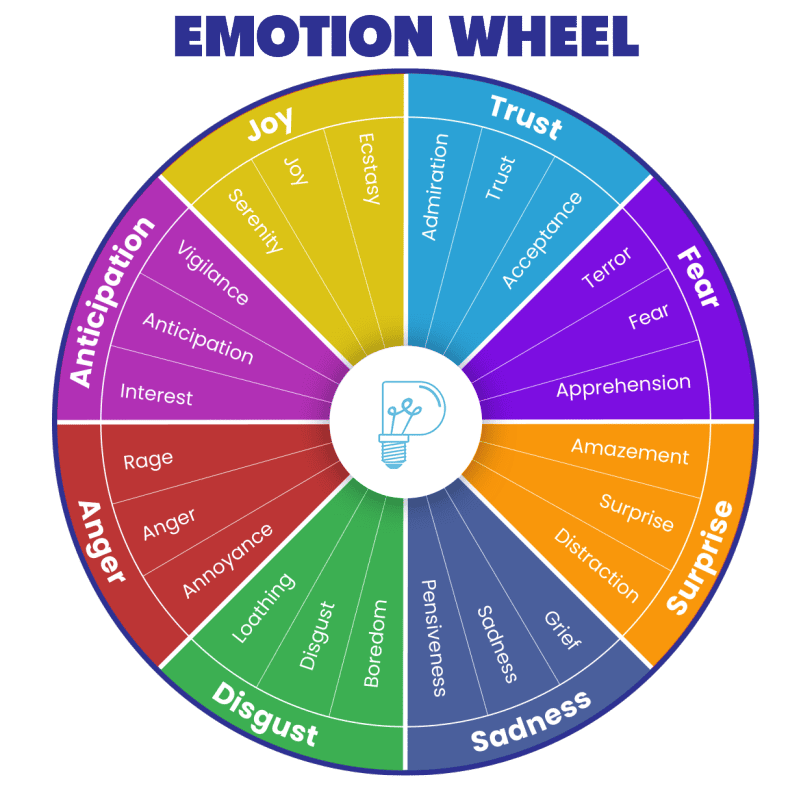
Robert Plutchik, an American psychologist, created the Emotion Wheel in 1980. His theory of emotion expanded on previous theories, some of which had labeled six primary emotions that all human beings feel. Plutchik believed that humans experience eight primary emotions, and each of these emotions has a polar opposite that is also included on the wheel:
- Joy, and its opposing emotion, sadness.
- Fear, and its opposing emotion, anger.
- Anticipation, and its opposing emotion, surprise.
- Disgust, and its opposing emotion, trust.
Already, this wheel begins to resemble a color wheel. But there is more to the Emotion Wheel than just eight primary emotions.
Combinations
You have probably found yourself in between two emotions. You feel joy, but you also feel anticipation. Maybe you’re waiting for a check in the mail or are particularly excited about the year to come. Plutchik covered these emotions, too. In between each emotion is an emotion that combines two adjoining emotions:
- Anticipation and joy: optimism
- Anger and anticipation: aggressiveness
- Joy and trust: love
- Trust and fear: submission
- Fear and surprise: awe
- Surprise and sadness: disapproval
- Sadness and disgust: remorse
- Disgust and anger: contempt
But we’re not done quite yet.
Degrees
Saying that you feel “joy” doesn’t always feel like enough to cover the full spectrum of that one emotion. Some days, you’re jumping out of your set with joy! Other days, you are simply feeling calm and happy. On either side of the primary emotions, Plutchik listed “degrees” in which these emotions can be felt.
These spectrums look like this:
- Anger: annoyance to rage
- Anticipation: interest to vigilance
- Disgust: boredom to loathing
- Fear: apprehension to terror
- Joy: serenity to ecstasy
- Sadness: pensiveness to grief
- Surprise: distraction to amazement
- Trust: acceptance to admiration
Plutchik has used both two-dimensional and three-dimensional models to show the relationship between primary emotions, the spectrum in which they sit, and the combination of emotions that we may experience at once.
List Of Emotions
To help you better understand your emotions, let's dive deep into each subcategory of the main categories. Along with naming each associated emotion, we'll also describe it so you can identify them within yourself.
Joy
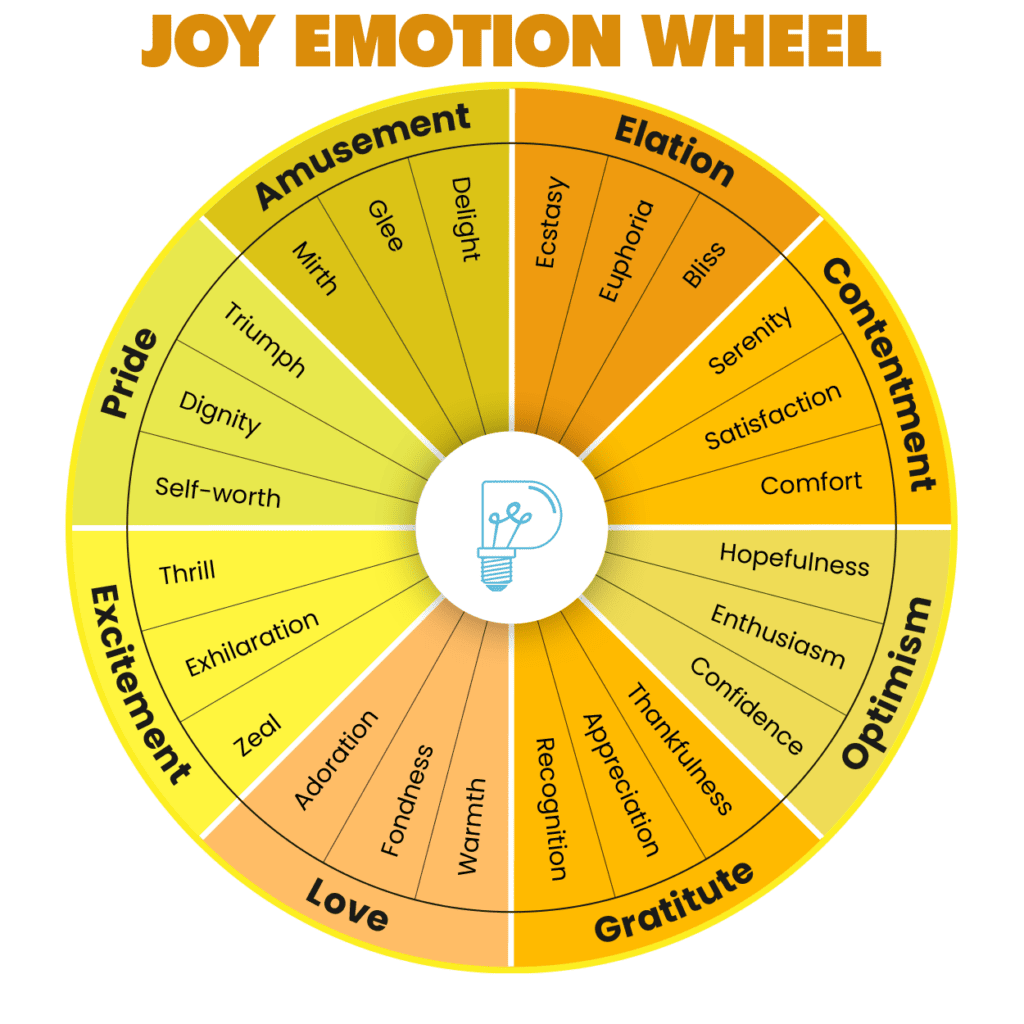
Joy is an emotion characterized by a state of happiness, pleasure, or satisfaction. It arises from positive experiences, achievements, or favorable outcomes, and can range from contentment to intense bliss, infusing life with a sense of optimism and excitement.
- Contentment: A feeling of inner peace and satisfaction.
- Elation: An overwhelming sense of happiness, often marked by exhilaration and enthusiasm.
- Cheerfulness: Feeling generally positive and upbeat, it is a lighter form of happiness.
- Excitement: A heightened state of energetic happiness, often linked to anticipation.
- Jubilation: A sense of extreme joy that often comes from a victory or achievement.
- Gratification: A feeling of pleasure and satisfaction due to a fulfilled desire or achieved goal.
- Hopefulness: Feeling positive about the future, which can lead to feelings of joy.
- Thrill: A high degree of pleasure or excitement.
- Triumph: An emotion that is experienced after a significant achievement.
- Optimism: A general tendency to expect the best possible outcome or focus on the most positive aspects of a situation.
- Ecstasy: An intense joy or delight often causing a near-transcendent state of emotion.
- Amusement: A state of being entertained or finding something funny.
- Relief: A feeling of reassurance and relaxation following worry or fear.
- Enthusiasm: An intense and eager enjoyment or interest.
- Pride: A feeling of satisfaction derived from one's own achievements or the accomplishments of those with whom one is closely associated.
Sadness
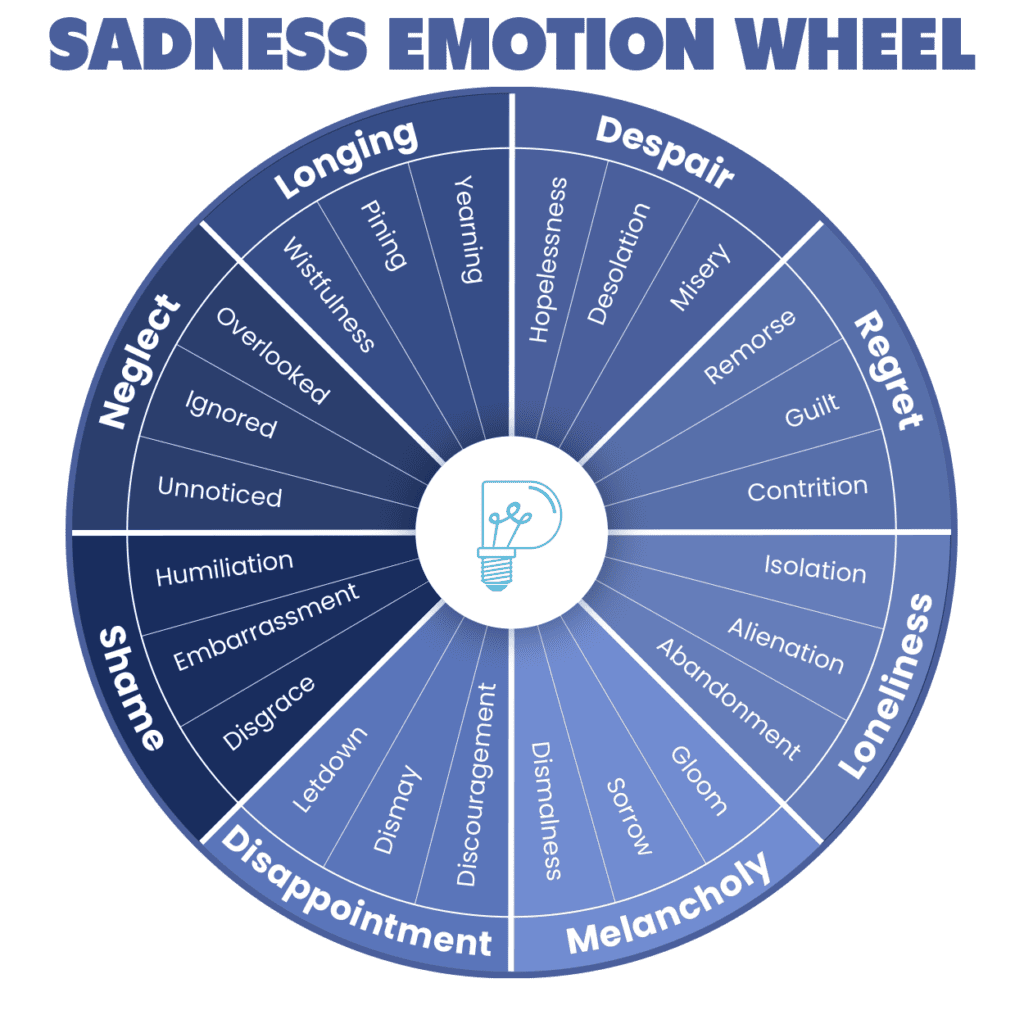
Sadness is a complex emotional state that stems from experiences of loss, disappointment, or frustration. It can manifest as feelings of sorrow, loneliness, despair, or grief, marking periods of difficulty but also potentially leading to personal growth and emotional depth.
- Sorrow: Deep distress, sadness, or regret especially for the loss of someone or something loved.
- Disappointment: A feeling of dissatisfaction that follows the failure of expectations to manifest.
- Despair: The complete loss or absence of hope.
- Shame: A painful feeling of humiliation or distress caused by the consciousness of wrong or foolish behavior.
- Loneliness: An unhappy emotion that stems from a perceived lack of companionship or isolation.
- Melancholy: A feeling of pensive sadness, often with no obvious cause.
- Hopelessness: A feeling or state of despair, usually over prolonged periods.
- Dismay: A strong feeling of distress or shock due to disappointment or fear.
- Neglect: A feeling of being ignored or neglected.
- Desolation: A state of complete emptiness or loneliness, often linked to sadness.
- Alienation: Feeling isolated and disconnected from others or society.
- Anguish: Severe mental or physical pain or suffering, often rooted in sorrow.
- Regret: A feeling of sadness or disappointment over something that has happened or been done, especially a loss or missed opportunity.
- Guilt: A feeling of having done wrong or failed in an obligation.
- Grief: Intense sorrow, especially caused by someone's death.
Fear
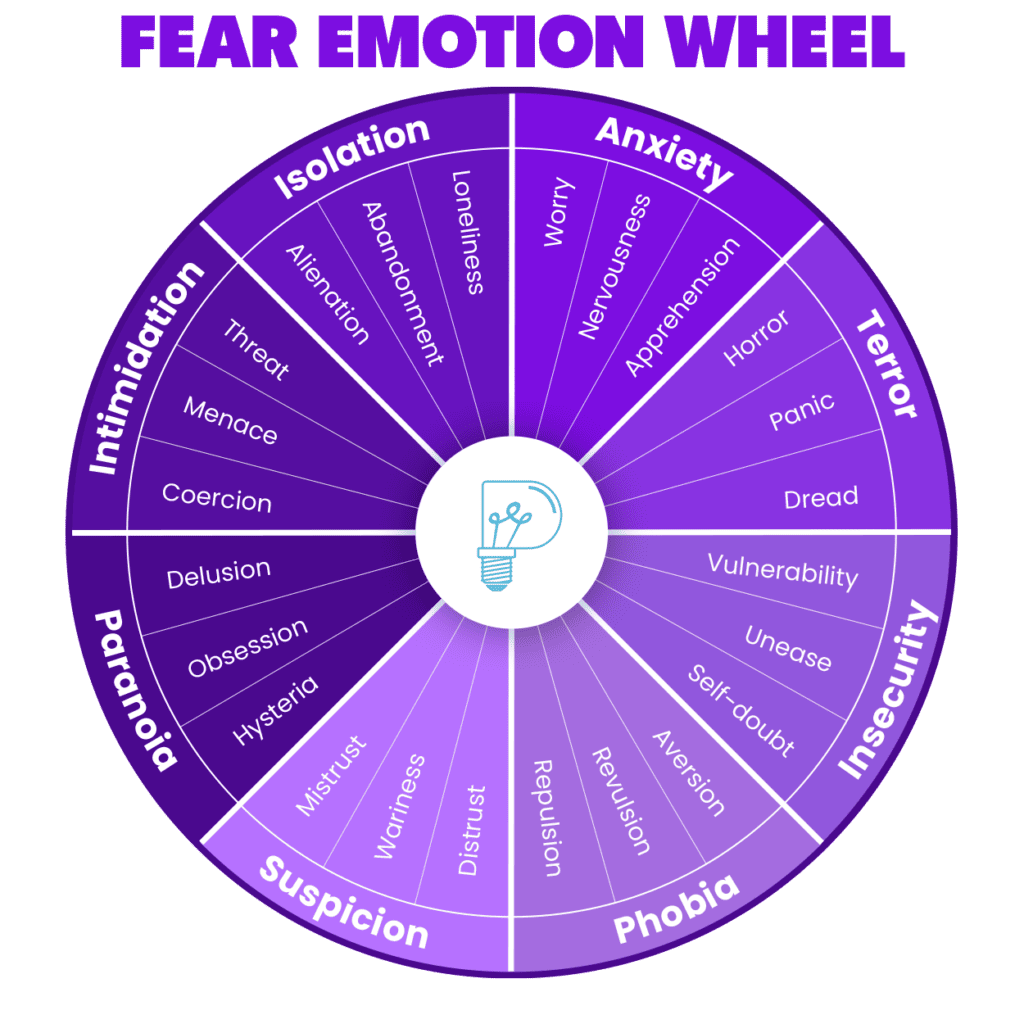
Fear is a primal emotion triggered by perceived danger or threat, causing feelings of anxiety, dread, or terror. It is essential for survival, but when intense or prolonged, it can lead to distress and interfere with a person's ability to function effectively.
- Anxiety: A feeling of worry, nervousness, or unease, typically about an imminent event or something with an uncertain outcome.
- Dread: Great fear or apprehension about something that will or may happen.
- Panic: Sudden uncontrollable fear or anxiety, often causing wildly unthinking behavior.
- Terror: Extreme fear, typically an overwhelming and disturbing feeling.
- Alarm: A state of fear or anxiety caused by an unexpected disturbance or perceived threat.
- Horror: Intense feelings of fear, shock, or disgust.
- Fright: A sudden intense feeling of fear.
- Phobia: An extreme or irrational fear of or aversion to something.
- Apprehension: Anxiety or fear that something bad will happen.
- Hysteria: Exaggerated or uncontrollable emotion or excitement, often due to fear.
- Nervousness: A state of restlessness or unease due to fear or anxiety.
- Insecurity: Uncertainty or anxiety about oneself; lack of confidence.
- Distress: Extreme anxiety, sorrow, or pain.
- Worry: A state of anxiety and uncertainty over actual or potential problems.
- Intimidation: The feeling of discouragement or fear caused by the presence or demeanor of someone or something perceived as powerful or threatening.
Anger
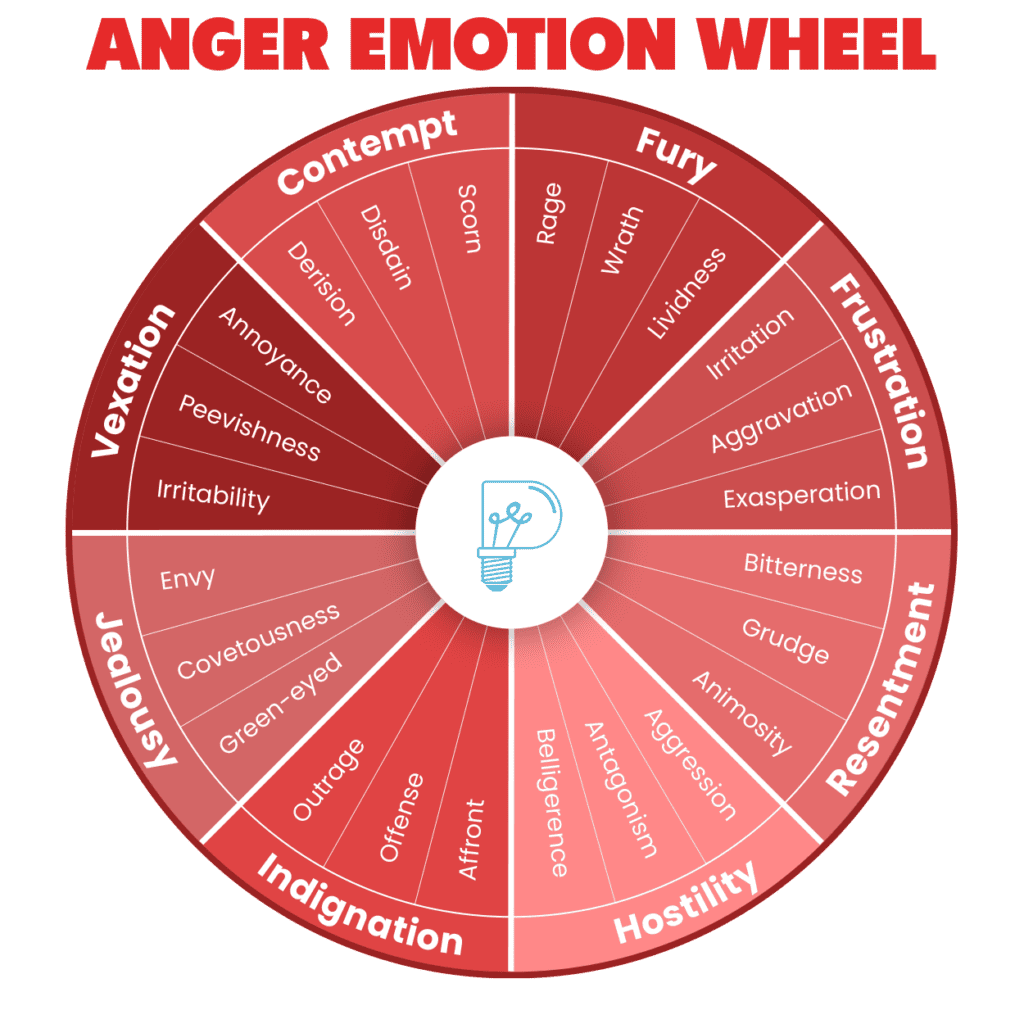
Anger is a strong emotion that arises in response to perceived wrongs or injustices. While it can range from mild irritation to intense fury or outrage, it serves as a signal that one's boundaries have been crossed, potentially driving protective action or inciting change.
- Fury: Intense, explosive anger.
- Outrage: A strong reaction of anger or shock due to a perceived injustice or offense.
- Irritation: Mild anger provoked by perceived annoying actions.
- Frustration: A feeling of dissatisfaction or annoyance when hindered in attempting to reach a goal.
- Resentment: Persistent anger or bitterness due to a perceived slight or unfair treatment.
- Annoyance: Mild anger caused by the actions of others that are perceived as inconvenient or irritating.
- Indignation: Anger provoked by what is perceived as unfair treatment.
- Hostility: An aggressive form of anger, which can often lead to confrontational behavior.
- Aggravation: A heightened state of irritation or annoyance.
- Rage: Uncontrollable anger that usually provokes aggressive behavior.
- Exasperation: Intense irritation and frustration.
- Disgust: A feeling of revulsion or profound disapproval aroused by something unpleasant or offensive.
- Jealousy: Anger or bitterness at one's perceived disadvantage in relation to others.
- Contempt: A strong feeling of disapproval and dislike for someone or something.
- Vexation: The state of being annoyed, frustrated, or worried.
Anticipation
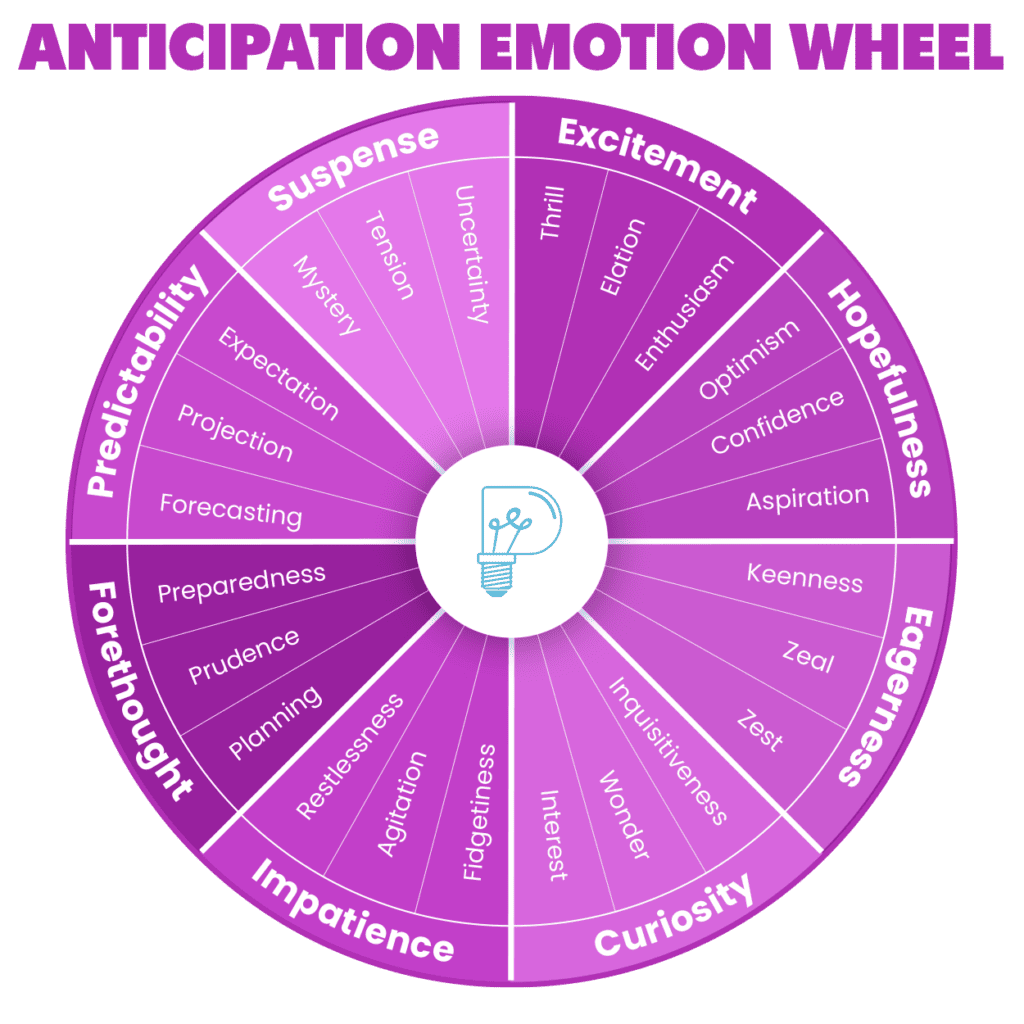
Anticipation is an emotional response to the expectation or foresight of future events. Whether filled with hope, excitement, or anxiety, anticipation helps us prepare for what lies ahead, adding a dimension of projection and planning to our emotional lives.
- Expectancy: The state of thinking or hoping that something pleasant will happen.
- Excitement: Feeling thrilled about a future event or outcome.
- Impatience: An eagerness to have something happen, often leading to restlessness.
- Optimism: A hopeful anticipation that future events will be favorable.
- Eagerness: Enthusiastic desire or readiness for something.
- Hope: A feeling of expectation and desire for a particular thing to happen.
- Suspense: A state of mental uncertainty or excitement, as in awaiting a decision or outcome.
- Tension: An anxious awareness of the need to meet a future goal or expectation.
- Uncertainty: A state of anticipation where the outcome is not yet known.
- Forethought: Thinking in advance, often leading to anticipation.
- Preparedness: The state of readiness in anticipation of something happening.
- Confidence: Believing in one's ability to handle what's coming.
- Yearning: A strong desire or longing for something in the future.
- Anxiety: A feeling of worry, often rooted in fear of upcoming events.
- Curiosity: A desire to know what will happen.
Surprise
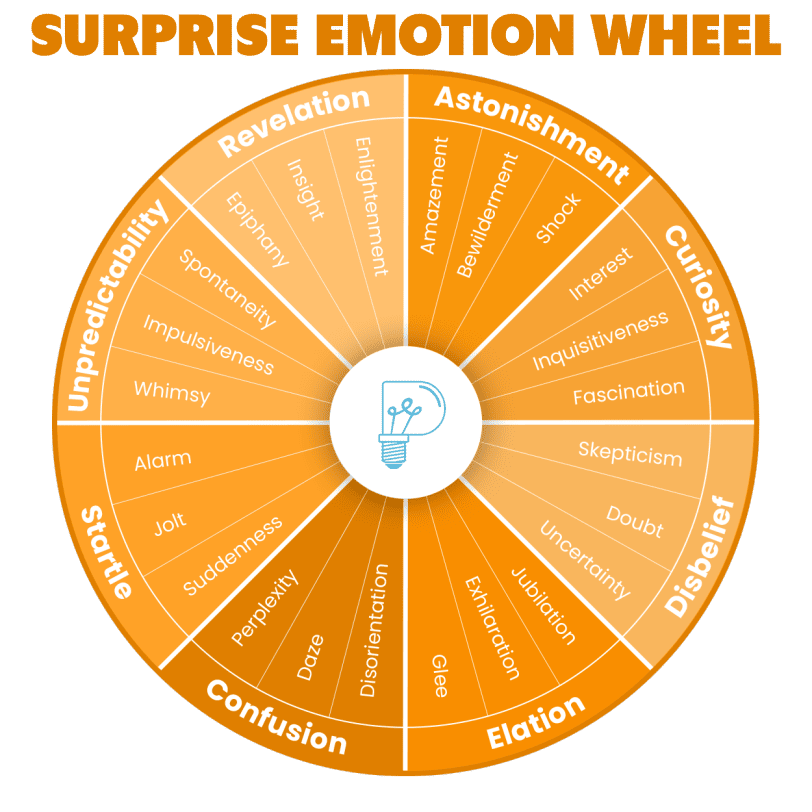
Surprise is an emotion that arises from unexpected or novel events, sparking reactions ranging from shock to delight. This emotional jolt can disrupt our assumptions or patterns, challenging us to adapt, reassess, and engage with the unpredictability of life.
- Astonishment: A feeling of great surprise or wonder.
- Shock: A sudden upsetting or surprising event or experience.
- Disbelief: A state of being unable to believe something, often leading to surprise.
- Amazement: Overwhelming surprise or wonder.
- Startlement: A sudden, shocked reaction.
- Bewilderment: A feeling of being perplexed or confused, often linked with surprise.
- Dismay: The feeling of distress, typically due to something unexpected.
- Elation: Joyous surprise, often due to an unexpected positive event.
- Confusion: Lack of understanding or uncertainty, often a result of a surprising situation.
- Disorientation: A state of mental confusion as to time, place, or identity, often resulting from a surprise.
- Flabbergast: To overwhelm with surprise or shock.
- Perplexity: Inability to deal with or understand something unexpected or puzzling.
- Stupefaction: The state of being unable to think or feel properly due to surprise.
- Speechlessness: The state of being too surprised or shocked to speak.
- Consternation: A feeling of anxiety or dismay, typically at something unexpected.
Disgust
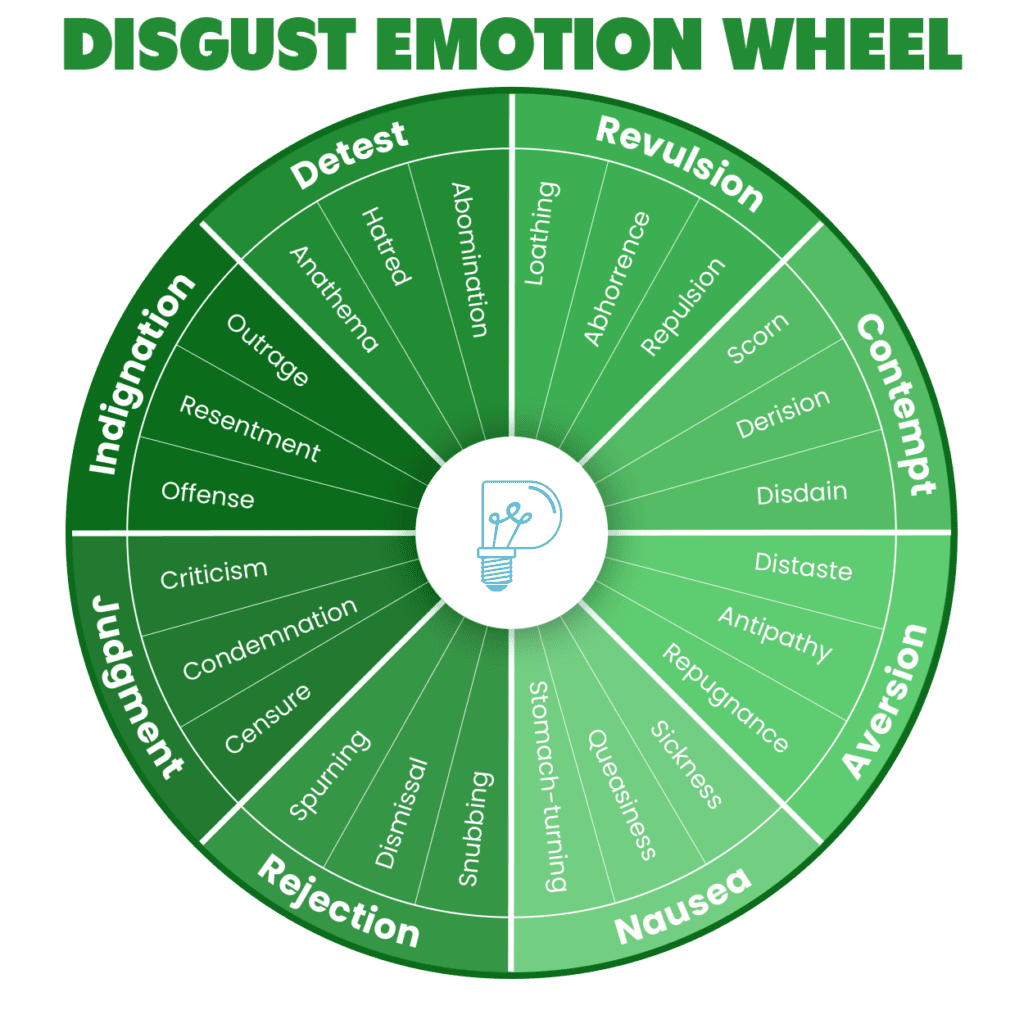
Disgust is a powerful emotional response that triggers rejection or avoidance of unpleasant, offensive, or harmful stimuli. Ranging from mild distaste to deep revulsion, disgust serves a protective role, steering us away from potentially harmful situations or substances.
- Repugnance: Intense disgust.
- Revulsion: A sense of loathing or complete rejection.
- Contempt: A feeling of disdain or intense dislike.
- Distaste: A mild version of disgust, often associated with dislike.
- Abhorrence: A feeling of repulsion; despising something or someone.
- Loathing: A strong, intense feeling of hatred or disgust.
- Repulsion: A feeling of intense distaste or disgust.
- Nausea: Physical unease and discomfort due to disgust.
- Revolt: A strong sense of disgust that results in a feeling of wanting to avoid or reject something.
- Aversion: A strong dislike or disinclination.
- Scorn: The feeling or belief that someone or something is worthless or despicable.
- Outrage: An extreme reaction to something perceived as disgusting or offensive.
- Detestation: Intense dislike or disgust.
- Antipathy: A deep-seated feeling of aversion or disgust.
- Horror: A strong feeling of shock or disgust.
Trust
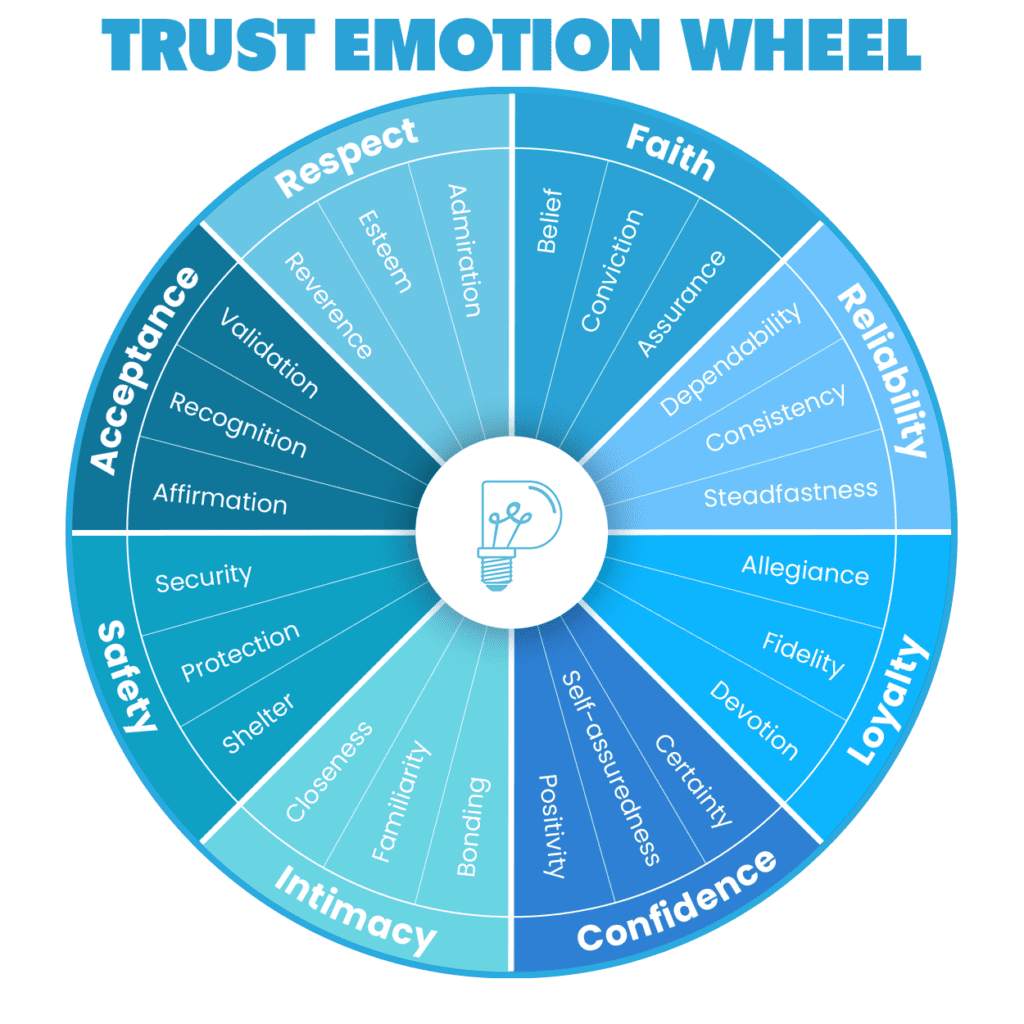
Trust is a positive emotional state that reflects reliance on the integrity and character of another person or concept. From the expectation of reliability to deep-seated confidence, trust is a vital component of functional relationships and societal structures, fostering cooperation and encouraging mutual support.
- Confidence: Belief in someone's reliability or ability.
- Faith: Complete trust or confidence in someone or something.
- Dependence: Relying on someone in expectation of their reliability.
- Assurance: A positive declaration intended to give confidence.
- Reliance: Trusting someone or something for support or help.
- Expectation: A strong belief that something will happen or be the case.
- Hope: A feeling of trust and expectation for the future.
- Certainty: A feeling of absolute trust in the truth of something.
- Belief: Acceptance that something is true or exists, often associated with trust.
- Fidelity: Loyalty or faithfulness to commitments or obligations.
- Conviction: A firmly held belief or opinion.
- Credence: Belief in or acceptance of something as true.
- Optimism: A general tendency to trust that the future will be positive.
- Loyalty: A strong feeling of allegiance or support.
- Security: The feeling of being free from danger or threat.
Emotions and Survival
Plutchik did not just create the Emotion Wheel so we could explore and identify our emotions. He was interested in the ways that emotions allow us to engage and learn basic survival mechanisms. His Psychoevolutionary Theory of Emotions included The Sequential Model of Emotions and the Place of Cognitions, which showed how this process took place. Each survival mechanism, from fight or flight to mapping out new territory, is linked to one of the eight primary emotions.
When we encounter a threat, for example, we need to do something in order to escape that threat and survive. Plutchik called the encounter of a threat a “stimulus event.” The inferred cognition that occurs in response to this stimulus is “danger.” The emotion that we feel is fear, ranging from apprehension to terror. Fear engages our “fight or flight mode,” and we end up fighting off the threat or fleeing the situation.
That is our behavior, in response to our emotions. The desired effect of our behavior is some form of survival. In this case, it’s protection from the threat. This sequence of events helps to explain the purpose and use of “fight or flight,” one of our most well-known defense mechanisms.
Evolution and Emotions
The Emotion Wheel, and other insights from Plutchik, remind us that we experience emotions for a reason. We may feel silly after having an emotional response to our ice cream falling on the ground or getting ghosted by a potential mate. But these emotions are traced back to basic survival mechanisms that kept us alive when things weren’t so convenient.
Back in more primitive times, we needed fight or flight to help us address threats, like wild animals or an enemy tribe. Threats nowadays, like a D on a test or not getting a promotion, are not exactly as serious. Yet, our mind may still register them as threats, and the sequence engages our fight or flight response.
As we learn to identify our emotions, we can control them and prevent the use of inappropriate defense or survival mechanisms. Not all threats require us to fight or flight. By understanding where our emotional responses are coming from, we can better assess our behaviors and when it’s time to truly take action.
How to Identify Your Emotions

How are you feeling today?
Sometimes, you might find that this simple question has a simple answer. You are happy. Content. Sad. Excited. Other times, this simple question doesn’t have a simple answer. You are nervous, but you can’t tell if it’s a “good nervous” or a “bad nervous.” You are happy, but that happiness is mixed in with a twinge of guilt that prevents you from truly feeling happy.
Identifying emotions is not an easy process, but it is crucial to understanding the way that people think and behave. There are various cognitive theories about how emotion plays into our cognitive process and the decisions that we make. So it makes sense that psychologists want to get a good grip on how we identify emotions and how they play into our behaviors and attitudes.
With tools like The Emotion Wheel, we can put words to our feelings. Here are some other ways to identify your emotions and properly manage them more effectively:
With tools like The Emotion Wheel, we can put words to our feelings. Here are some other ways to identify your emotions and manage them more effectively:
Sit with yourself
Take a moment to sit in a silent place and observe your body and mind. (Guided meditations on apps like Insight Timer can help you do this, too.) Do you feel tension anywhere in your body? Are your thoughts positive, negative, hopeful, etc.? Be patient and honest with yourself. Take 5-10 minutes to go through this process.
Refer to The Emotion Wheel afterward. Do your thoughts reflect a feeling of anxiety? Contentment? Embarrassment? Start from the innermost circle and move outward if you have to.
Keep a journal nearby
We can't always process our emotions by thinking the same thoughts over and over in our heads. Take time to write out the events of the day and how you feel as you reflect. Regularly committing to a journal will not only reveal your emotions to you but also the sources of those emotions.
Accept all emotions
Your emotions are valid. We often do not want to admit to experiencing feelings like shame, sadness, or disappointment. Know that these feelings are completely normal. We all experience certain feelings, even when we have not done anything to "deserve" them. The sooner you can admit your feelings, the sooner you can manage them.
The Importance of Emotional Intelligence
Identifying your emotions, through the use of the Emotion Wheel or otherwise, builds EQ. EQ, or emotional intelligence, is the ability to identify and use emotions effectively.
Emotional intelligence looks like:
- Managing emotions before they turn into impulse behavior
- Picking up on emotional cues and responding appropriately
- Clearly communicating your goals and emotions to your partner, colleagues, or friends
- Adapting to changing situations with ease
- Remaining calm, even in scary or tense situations
- Identifying strengths and weaknesses
- Connecting thought patterns and physical responses with certain emotions
- Knowing what events or topics may trigger strong emotions and preparing appropriately
Example of Using the Emotion Wheel To Gain Emotional Intelligence
Darren is not feeling good. When he sits down to work, he gets distracted by everything else on his to-do list. He thinks about his mother, who is sick in the hospital. He thinks about his wife, who has been feeling stressed out lately. And he thinks about his boss, who may or may not be disappointed in the lack of work that Darren has been able to accomplish.
Darren doesn't know how to explain his feelings. Left unchecked, his stress affects his sleep, ability to work out, and focus. It's not until he sees an article about The Emotion Wheel that he decides to take stock of his emotions.
He listens to a meditation on YouTube about identifying his emotions. The meditation instructs him to notice different parts of his body and mind. Darren realizes his chest is tight. His thoughts are moving very quickly. After the meditation, he Googles his symptoms and realizes he is experiencing anxiety.
This is new to Darren, but he has the Emotion Wheel to help him. He looks at the area that says, “Anxious.” In the innermost circle, he sees “fearful” encompassing “anxious”. Darren would not usually be a person to say that he is afraid, but he has an open mind. What could he be afraid of? Maybe he’s afraid that his mother won’t recover from her illness, or that his wife will become ill because she is so stressed.
He looks at the outermost circles on the Emotion Wheel: overwhelmed and worried. While both of those emotions seem to fit his current feelings, the sheer number of worries in his life is overwhelming him.
Darren decides to look up what to do when he’s overwhelmed, and talks to a friend and shares his overwhelm. Through this process, he realizes that he has too much time on his plate and has little time to devote to self-care and spending time with the people he loves. By focusing more of his energy on this, Darren finds that his symptoms of anxiety affect him far less often than before.
Emotional Intelligence and Behavior
Of course, emotional intelligence doesn’t end when you do something to resolve your feelings. Emotional intelligence can also help you if you find yourself acting out due to your emotions. Let’s say Darren’s boss tends to be critical of Darren whenever she is angry. She may not be angry at Darren, but her anger comes out through that behavior. When she learns about the Emotion Wheel, she sees the tie between criticism and anger.
The next time she finds herself getting angry, she takes some time to pause. How can she bring herself into the present moment and look for solutions? What is the best way to communicate her thoughts with Darren while reassuring him that he’s doing a good job? As she navigates the answers to these questions, she starts to communicate more effectively with Darren and he finds that he becomes less anxious at work, too.



